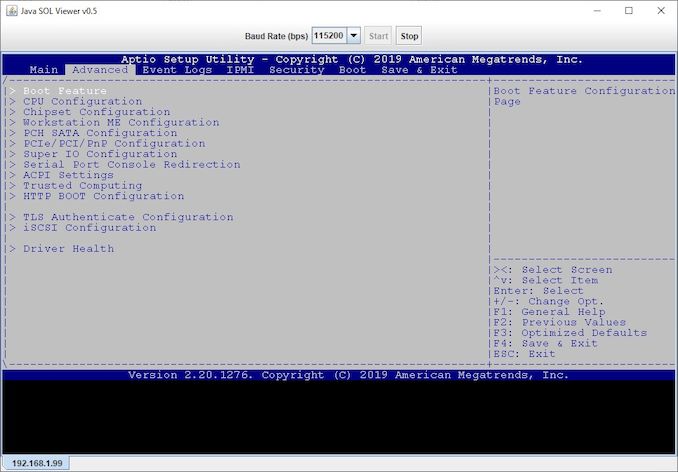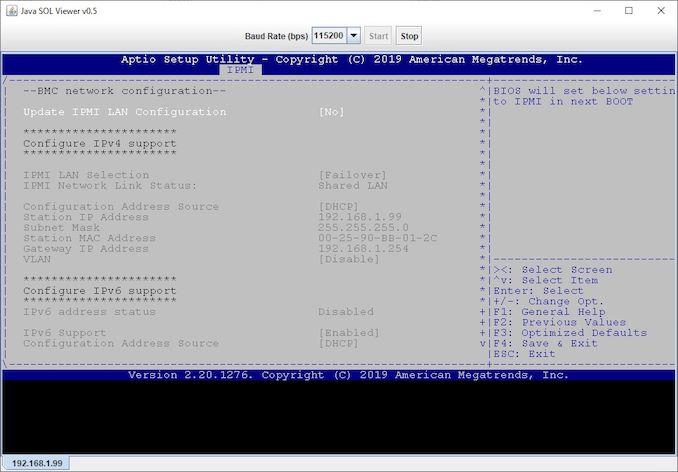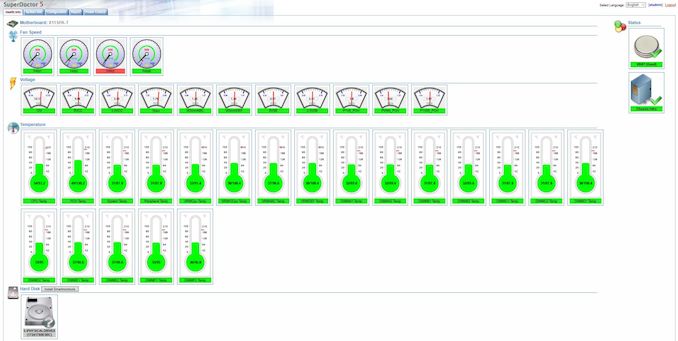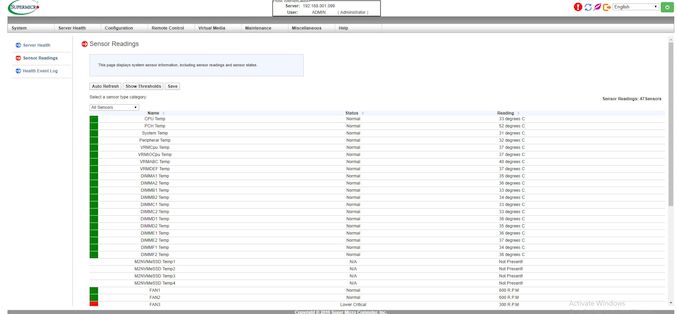The Supermicro X11SPA-T Review: An Impressive Cascade Lake Workstation Motherboard
by Gavin Bonshor on January 24, 2020 9:00 AM ESTBIOS
The Supermicro X11SPA-T is using a basic version of its UEFI BIOS, which is designed with function in mind and not aesthetics. The firmware GUI consists of a white background with black text, and blue highlights. Due to the firmware's archaic design, there is no screenshot capture hotkey. Instead, to pull images of the firmware, we had to connect to the system via the ASPEED AST2500 BMC controller and screenshot the screen from Java's SQL Viewer.
We updated the Supermicro X11SPA-T to the latest firmware, BIOS version 3.2, and to flash it we used the DOS command structure via the built-in EFI shell. Users can update the firmware through connection to the BMC as an alternative to DOS.
As with older style motherboard firmware, all of the menus are located along the top with primary menus including the main screen (as above), an advanced section, event logs, IPMI settings, security, boot, and the usual save & exit settings. The Supermicro X11SPA-T does not support overclocking of any kind, not even memory tuning which is common for a prosumer workstation focused model such as this one.
Under the advanced tab, users can customize multiple aspects of the system with the boot feature menu allowing users to enable or disable Windows 7 USB installation support. Other options include CPU power settings including the enabling and disabling of Multithreading, how many CPU cores are enabled, and settings such as Virtualization technology for running virtual machines. Users can also alter the configuration of the PCIe 3.0 slots with MMIO settings also present.
One of the key functions of the Supermicro X11SPA-T is that it allows users to connect remotely to the system via the Realtek8211E PHY on the rear panel. Within the firmware, users can view the status of the network including the IP address which is required to log in remotely from another system.
The Supermicro X11SPA-T motherboard is designed for professional use and omits the fancy GUI of desktop-based models. All of the core features from a workstation-based model are present including OS support, remote connectivity, and Supermicro does it without much fanfare. It's a conventional BIOS for a conventional workstation platform such as C621.
Software
Any form of software and driver installation media is excluded from the accessories bundle, but users can download a full disc image directly from the official product page on the Supermicro website. Aside from the drivers for key functions for the ASPEED BMC controller, audio drivers, and core Intel drivers, the only utility available is Supermicro's SuperDoctor 5 software.
The SuperDoctor 5 utility allows users to monitor hardware and integrated sensors remotely, as well within the system. It offers plenty of network management options including alerts, allows users to perform system resets and shutdowns, including firmware updates. This offers an alternative to the remote functionality of the BMC and offers a more friendly GUI. Similar to a 'Command Center' from other manufacturers, it allows real-time view of storage health, fan speed, temperatures etc.
Another alternative to connecting to the system via the static IP address. This provides a similar function to SuperDoctor 5, including monitoring, setting alerts, and checking system information. Users can also perform system maintenance and view the system in real-time through Java including the firmware. Other settings that can be customized include the date and time, IP Access Control, configuring the fans settings, as well as allowing users to upload SSL certificates.



























31 Comments
View All Comments
SSNSeawolf - Friday, January 24, 2020 - link
Gavin, can you comment as to why the W-3235 has a poor showing in some benchmarks, such as Ashes of the Singularity? It loses against it's older cousin, the 7900X, even though it has a slightly faster turbo, much more cache, more memory channels and the same mesh architecture.The only thing I can think of is that the 7900X is LCC Skylake silicon while the W-3235 is HCC, but it doesn't seem that such a big delta can be explained by an extra tile hop or two.
olafgarten - Friday, January 24, 2020 - link
As far as I know it's most likely because AOTS uses a lot of multiprocessing and so the HCC might make a difference therePCWarrior - Monday, January 27, 2020 - link
Three reasons for the difference:1. Looser memory timings (secondary, tertiary) on the workstation Supermicro boards compared to the enthusiast X299 ones with tighter timings. Also, likely looser primary timings (as well as looser secondary and tertiary) due to using 16GB DIMMs (and 6 of them) as opposed to 8GB DIMMS (and only 4 of them).
2. The cascade lake processors have built-in hardware mitigations that are known to have some performance impact. Sure this impact is smaller impact than equivalent software mitigations but larger impact than no security mitigations at all. The 7900X results show in the charts are likely from 2 years ago with no or fewer security mitigations applied.
3. Unlike enthusiast X299 boards that out-of-the box have no power limits and the cpu can turbo to its all-core turbo indefinitely, the Supermicro C246 boards adhere to Intel’s spec so the TDP is enforced after 28 (or so) seconds. So the 3235 in the above results was turboing to its all-core frequency (and we don’t know if it is 4GHZ as it is for the 7900X to begin with) for only 28 seconds - after that its frequency dropped to a value that would make the cpu power consumption not exceed 180W (i.e. equal to the TDP).
P.S: There is a mistake in the article. Specifically, under the Test Bed section it says that the board used was the X11SCA-W (instead of the X11SPA-T that this review is supposedly about). It also says that the RAM used was 2x16GB Corsair Vengeance LPX DDR4-2400 (run at 2666) which would have been the case for the X11SCA-W (mainstream 1151 socket and dual channel RAM). This board (the X11SPA-T) should have been tested with 6x16GB at 2933MHZ. Clearly the author forgot to fully update the table when he copy-pasted it from the older article about the X11SCA-W.
Tomatotech - Friday, January 24, 2020 - link
Nice to see how the big boys handle it. Most of my work is with mITX systems. Would be lovely to see a reasonably priced SFF mobo with more than 2 RAM slots and more than 1 nvme m.2 slot. There have been some but they’re not cheap.eastcoast_pete - Friday, January 24, 2020 - link
This board is outside my personal needs, but I would love to see a lower-priced good quality consumer ATX board with good VRMs, no LEDs and the appearance of this workstation board at a fair price. Something tells me I wouldn't be the only potential customer. Any takers?Foeketijn - Sunday, January 26, 2020 - link
I even emailed them to ask for a bullet proof no nonsense AM4 board (with official ECC support).otherwise - Tuesday, February 25, 2020 - link
The Asus "WS" boards are directly aimed at this market.watersb - Saturday, January 25, 2020 - link
Wow. Do I build one of these, or go for the Mac Pro?Licky McShmickletips - Saturday, January 25, 2020 - link
Please allow me to correct a small error in your postulation:"Do I build -two- of these, or buy one Mac Pro equivalent?"
Death666Angel - Saturday, January 25, 2020 - link
Do you need MacOS? Go with Apple. Do you just need a good workstation? Build it yourself. :)